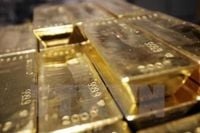The world gold price increased by 1.7% last week, driven by growing concerns over a potential global trade war sparked by the latest tariff measures proposed by U.S. President Donald Trump. As of 1:39 AM on March 29, 2025, Vietnam time, spot gold rose by 0.6% to $3,074.43 per ounce, having reached a record high of $3,086.70 earlier in the session. Meanwhile, U.S. gold futures closed up 0.8% at $3,114.30 per ounce.
Gold, often viewed as a hedge against economic and political instability, tends to thrive in low-interest-rate environments. The U.S. Personal Consumption Expenditure (PCE) price index saw a 0.4% increase in February 2025, surpassing analysts' expectations of 0.3% and matching January's rise. However, according to economic analyst Grant, this data is unlikely to alter expectations regarding interest rate cuts, as it only slightly exceeded forecasts.
The Federal Reserve has maintained interest rates steady this year after three cuts in 2024 but hinted at a potential 0.5 percentage point reduction by the end of the year. Current market predictions suggest the Fed may cut rates by 63 basis points by year-end, starting in July 2025.
Market participants are also bracing for Trump's announcement of reciprocal tariffs on April 2, 2025. Analysts warn that these policies could lead to inflation, pose risks to economic growth, and escalate trade tensions. The gold market experienced significant volatility last week, reflecting a tug-of-war between macroeconomic factors and market sentiment.
After a robust rally, gold prices dipped slightly at the beginning of the week on March 24, 2025. A stronger U.S. dollar, which reached a two-week high, exerted downward pressure on gold prices. Additionally, initial signals indicated that Trump might be more flexible regarding tariff implementation, temporarily dampening demand for gold as a safe haven.
However, gold prices rebounded on March 25, reflecting ongoing concerns about trade tensions. Investors quickly returned to the market, driven by fears that were reignited despite some hawkish comments from Fed officials regarding interest rate cuts. On March 26, gold prices saw a slight decline but remained above the crucial psychological threshold of $3,000 per ounce.
The market surged again on March 27, setting new records with spot prices exceeding $3,059 per ounce and futures prices above $3,071 per ounce. The escalation of trade tensions intensified after Trump announced tariffs on imported cars, prompting countries like Canada and France to declare they would respond. This announcement led to a sell-off in global stock markets, significantly boosting the flow of capital into gold as a last-resort safe haven asset.
Gold's recent surge opens the door for potential new milestones, with analysts from Goldman Sachs predicting prices could reach $3,100 per ounce, $3,150 per ounce, or even $3,300 per ounce by the end of the year.
In other precious metals, silver spot prices fell by 1.4% to $33.93 per ounce on March 28, while platinum dropped 0.7% to $979.10 and palladium decreased by 0.3% to $972.13. Nonetheless, all three metals recorded weekly gains.
On the domestic front, gold prices in Vietnam mirrored the international trend, reaching new heights on March 29, approaching the 101 million VND per tael mark. The domestic gold market has been closely monitoring global movements, with prices reflecting the same upward trajectory.
As gold prices soar, demand in Asia is waning, with investors hesitant to buy at such elevated levels. In India, sluggish demand persists, attributed to record high prices. The country's financial year runs from April to March, and domestic gold prices recently hit a peak of 89,796 rupees per 10 grams, marking a nearly 15% increase since the start of 2025.
Indian gold traders have been offering discounts of up to $33 per ounce compared to official domestic prices, which include a 6% import tax and a 3% sales tax. This discount has narrowed from a maximum of $41 the previous week, indicating a cautious market. Retail demand remains minimal, with jewelry stores across India reporting a decline in customer traffic.
In China, the world's leading gold consumer, traders are pricing gold with fluctuations ranging from a $4 discount to a $1 premium per ounce compared to international prices. Independent analyst Ross Norman noted, “We are witnessing a drop in demand due to rising gold prices.” China's net gold imports through Hong Kong plunged more than fivefold in February, falling below export levels for the second consecutive month, while gold supplies from Switzerland to China dwindled entirely in February.
In Hong Kong, gold is being sold at par or with a $2 premium, while Singaporean traders are applying prices ranging from par to a $2.5 premium. In Japan, gold bars are available at a discount of $0.5 to a premium of $0.7. A trader in Japan indicated that domestic investors are waiting for prices to drop before making purchases, despite expectations of a stronger yen following potential interest rate hikes.
The current landscape of the gold market reflects a complex interplay of factors, including geopolitical tensions, economic indicators, and shifting investor sentiment. As the situation unfolds, both domestic and international markets will continue to react to developments in trade policies and economic forecasts.





